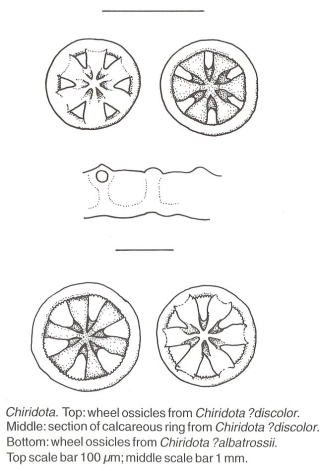Several species of Chiridota have been described from the waters of the northeastern Pacific. The species are poorly defined and difficult to distinguish; so until the taxonomy is revised, I cannot present definitive descriptions. C. albatrossii has the most complete description and is probably the common deepwater species.
All species are wormlike, varying in length up to 30 cm. Five longitudinal muscles and other organs are visible through the translucent skin. A series of white bumps (wheel papillae) of varying number occur in rows along the length of the body. These papillae contain clusters of microscopic wheel ossicles. The top pair in the figure is from a specimen collected near Auke Bay, Alaska, and the lower pair from near Victoria. There is a slight difference in size and detail, but they do not appear to be significantly different. Feeding tentacles are short and clawlike and range in number from 12 to 15, with 8 to 12 side branches. When freshly dredged, swollen sections of the body look like clear jelly beans.
Chiridota discolor can grow up to 30 cm long. It ranges in colour from whitish, yellowish, greyish, reddish to brownish: the shade depending on the abundance of red pigment in the skin and degree of contraction of the body. It has 12 tentacles, each with 4 or 5 pairs of digits. The few wheel papillae are usually confined to the dorsal side of the body in irregular rows. The diameter of the wheels is 50-105 μm. No other types of ossicles are found.
Similar SpeciesChiridota is similar to the other common wormlike genus, Leptosynapta, but Leptosynapta is usually yellow, reddish or white; it has no rows of white spots, and it inhabits muddy intertidal or shallow subtidal areas. Leptosynapta species have anchors and anchor plates in the skin, not wheel ossicles.
